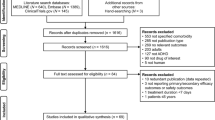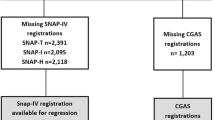Abstract
While attention deficit hyperactivity disorder (ADHD) and obsessive compulsive disorder have been shown to have major impacts on quality of life in individuals with Tourette syndrome, there is comparatively little data on how the presence of these comorbidities influence tic severity and treatment. 114 children (mean age 10.25 years) were extensively clinically phenotyped at a single specialty clinic. While there was no difference in Yale Global Tic Severity Scale (YGTSS) scores in children with versus without ADHD, children with obsessive compulsive behaviors had significantly higher YGTSS scores (p = 0.008). There was a significant correlation between YGTSS scores and age (r = 0.344, p < 0.001). Children with ADHD were more likely to be treated for their tics within the first two years of diagnosis (OR 3.51, p = 0.009). As tic severity does not appear to be greater in children with ADHD, this association may relate to greater overall psychosocial impairment in children with this comorbidity.
Similar content being viewed by others
References
Knight T, Steeves T, Day L, Lowerison M, Jette N, Pringsheim T (2012) Prevalence of tic disorders: a systematic review and meta-analysis. Pediatr Neurol 47(2):77–90. doi:10.1016/j.pediatrneurol.2012.05.002
Bloch MH, Leckman JF (2009) Clinical course of Tourette syndrome. J Psychosom Res 67(6):497–501
Bloch MH, Peterson BS, Scahill L, Otka J, Katsovich L, Zhang H et al (2006) Adulthood outcome of tic and obsessive-compulsive symptom severity in children with Tourette syndrome. Arch Pediatr Adolesc Med 160(1):65–69. doi:10.1001/archpedi.160.1.65
Yang J, Hirsch L, Martino D, Jette N, Roberts J, Pringsheim T (2016) The prevalence of diagnosed tourette syndrome in Canada: a national population-based study. Mov Disord 31(11):1658–1663. doi:10.1002/mds.26766
Kurlan R, Como P, Miller B, Palumbo D, Deeley C, Andresen EM et al (2002) The behavioural spectrum of tic disorders. A community based study. Neurology 59:414–420
Hirschtritt ME, Lee PC, Pauls DL, Dion Y, Grados MA, Illmann C, et al. Lifetime prevalence, age of risk, and genetic relationships of comorbid psychiatric disorders in Tourette syndrome. JAMA Psychiatry. 2015;72(4):325–333. doi:10.1001/jamapsychiatry.2014.2650
Ganos C, Roessner V, Munchau A (2013) The functional anatomy of Gilles de la Tourette syndrome. Neurosci Biobehav Rev 37(6):1050–1062. doi:10.1016/j.neubiorev.2012.11.004
Milad MR, Rauch SL (2012) Obsessive-compulsive disorder: beyond segregated cortico-striatal pathways. Trends Cogn Sci 16(1):43–51. doi:10.1016/j.tics.2011.11.003
Browne HA, Hansen SN, Buxbaum JD, Gair SL, Nissen JB, Nikolajsen KH, et al. Familial clustering of tic disorders and obsessive-compulsive disorder. JAMA Psychiatry. 2015;72(4):359–366. doi:10.1001/jamapsychiatry.2014.2656
Stewart SE, Illmann C, Geller DA, Leckman JF, King R, Pauls DL (2006) A controlled family study of attention-deficit/hyperactivity disorder and Tourette’s disorder. J Am Acad Child Adolesc Psychiatry 45(11):1354–1362. doi:10.1097/01.chi.0000251211.36868.fe
Kern JK, Geier DA, King PG, Sykes LK, Mehta JA, Geier MR (2015) Shared brain connectivity issues, symptoms, and comorbidities in autism spectrum disorder, attention deficit/hyperactivity disorder, and Tourette syndrome. Brain Connect 5(6):321–335. doi:10.1089/brain.2014.0324
Gilbert DL, Bansal AS, Sethuraman G, Sallee FR, Zhang J, Lipps T et al (2004) Association of cortical disinhibition with tic, ADHD, and OCD severity in Tourette syndrome. Mov Disord 19(4):416–425. doi:10.1002/mds.20044
Orth M, Rothwell JC (2009) Motor cortex excitability and comorbidity in Gilles de la Tourette syndrome. J Neurol Neurosurg Psychiatry 80(1):29–34. doi:10.1136/jnnp.2008.149484
Sukhodolsky DG, Scahill L, Zhang H, Peterson BS, KIng R, Lombroso PJ et al (2003) Disruptive behaviour in children’s with Tourette’s syndrome: association with ADHD comorbidity, tic severity and functional impairment. J Am Acad Child Adolesc Psychiatry 42(1):98–105. doi:10.1097/01.CHI.0000024904.60748.3A
Roessner V, Becker A, Banaschewski T, Freeman RD, Rothenberger A, Tourette Syndrome International Database C (2007) Developmental psychopathology of children and adolescents with Tourette syndrome–impact of ADHD. Eur Child Adolesc Psychiatry 16(Suppl 1):24–35. doi:10.1007/s00787-007-1004-6
Pringsheim T, Lang A, Kurlan R, Pearce M, Sandor P (2009) Understanding disability in Tourette syndrome. Dev Med Child Neurol 51(6):468–472. doi:10.1111/j.1469-8749.2008.03168.x
Storch EA, Merlo LJ, Lack C, Milsom VA, Geffken GR, Goodman WK et al (2007) Quality of life in youth with Tourette’s syndrome and chronic tic disorder. J Clin Child Adolesc Psychol 36(2):217–227
Ford T, Goodman R, Meltzer H (2003). The British Child and Adolescent Mental Health Survey 1999: The prevalence of DSM-IV disorders. J Am Acad Child Adolesc Psychiatry. 42(10):1203–1211.
Leckman JF, Zhang H, Vitale A, Lahnin F, Lynch K, Bondi C et al (1998) Course of tic severity in Tourette syndrome: the first two decades. Pediatrics 102(1 Pt 1):14–19
Lebowitz ER, Motlagh MG, Katsovich L, King RA, Lombroso PJ, Grantz H et al (2012) Tourette syndrome in youth with and without obsessive compulsive disorder and attention deficit hyperactivity disorder. Eur Child Adolesc Psychiatry 21(8):451–457. doi:10.1007/s00787-012-0278-5
Santangelo SL, Pauls DL, Goldstein JM, Faraone SV, Tsuang MT, Leckman JF (1994) Tourette’s Syndrome: what are the influences of gender and comorbid obsessive-compulsive disorder? J Am Acad Child Adolesc Psychiatry 33(6):795–804
March JS, Biederman J, Wolkow R, Safferman A, Mardekian J, Cook EH et al (1998) Sertraline in children and adolescents with obsessive-compulsive disorder: a multicenter randomized control trial. JAMA 280:1752–1756
March JS, Franklin ME, Leonard H, Garcia A, Moore P, Freeman J et al (2007) Tics moderate treatment outcome with sertraline but not cognitive-behavior therapy in pediatric obsessive-compulsive disorder. Biol Psychiatry 61(3):344–347. doi:10.1016/j.biopsych.2006.09.035
Hojgaard DR, Skarphedinsson G, Nissen JB, Hybel KA, Ivarsson T, Thomsen PH (2016) Pediatric obsessive-compulsive disorder with tic symptoms: clinical presentation and treatment outcome. Eur Child Adolesc Psychiatry. doi:10.1007/s00787-016-0936-0
Pringsheim T, Steeves T (2011) Pharmacological treatment for attention deficit hyperactivity disorder (ADHD) in children with comorbid tic disorders. Cochrane Database Syst Rev 4 (CD007990)
Kurlan R, Goetz CG, McDermott MP, Plumb S, Singer H, Dure L et al (2002) Treatment of ADHD in children with tics: A randomized controlled trial. Neurology 58(4):527–536
Pringsheim T, Hirsch L, Gardner D, Gorman DA (2015) The pharmacological management of oppositional behaviour, conduct problems, and aggression in children and adolescents with disruptive behaviour disorders: a systematic review and meta-analysis. Part 1: psychostimulants, alpha-2 agonists, and atomoxetine. Can J Psychiatry 60(2):42–51
Scahill L, Chappell PB, Kim YS, Schultz RT, Katsovich L, Shepherd E et al (2001) A placebo-controlled study of guanfacine in the treatment of children with tic disorders and attention deficit hyperactivity disorder. Am J Psychiatry 158(7):1067–1074
Murphy TK, Lewin AB, Storch EA, Stock S (2013) Practice parameter for the assessment and treatment of children and adolescents with tic disorders. J Am Acad Child Adolesc Psychiatry 52(12):1341–1359
McGuire JF, Arnold E, Park JM, Nadeau JM, Lewin AB, Murphy TK et al (2015) Living with tics: reduced impairment and improved quality of life for youth with chronic tic disorders. Psychiatry Res 225(3):571–579. doi:10.1016/j.psychres.2014.11.045
Author information
Authors and Affiliations
Corresponding author
Ethics declarations
Conflict of interest
There is no conflict of interest.
Rights and permissions
About this article
Cite this article
Pringsheim, T. Tic Severity and Treatment in Children: The Effect of Comorbid Attention Deficit Hyperactivity Disorder and Obsessive Compulsive Behaviors. Child Psychiatry Hum Dev 48, 960–966 (2017). https://doi.org/10.1007/s10578-017-0718-z
Published:
Issue Date:
DOI: https://doi.org/10.1007/s10578-017-0718-z




